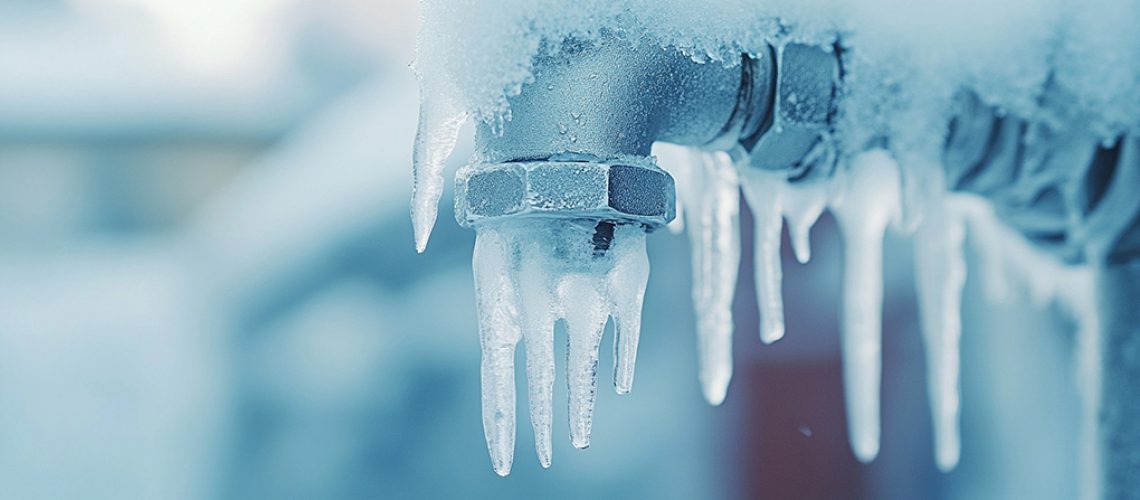Winter is here and we will all say it more than once: “I’m freezing!” But how often do we think about our pipes? Probably not enough—and that’s a problem. Frozen pipes can burst, causing one of the most common (and costly) types of property damage. In fact, according to the Insurance Institute for Business and Home Safety, a burst pipe can lead to an average of $5,000 in damage. Surprised? It’s true. And it’s not just the cost, but the inconvenience that can lead to huge headaches. Let’s make sure you’re not caught off guard.
Here’s how to keep your pipes safe from freezing and what to do if you suspect you’ve got a frozen pipe.
Which Pipes Are Most Likely to Freeze, and When?
Temperatures of 20°F or lower are the danger zone for frozen pipes. In those temperatures, pipes can freeze in just 4 or 5 hours. The ones most at risk?
- Pipes in unheated areas like the garage, basement, or attic.
- Pipes near exterior walls or inside cabinets.
- Outdoor water lines like hose hookups, swimming pool supply lines, and sprinkler systems.
Don’t wait till the forecast predicts freezing temperatures. The time to take action is now.
How to Prevent Frozen Pipes
Good news! Preventing frozen pipes is relatively simple and affordable. A little preparation goes a long way! Here’s what you can do:
1. Keep Your Home Warm
Maintain an indoor temperature of at least 55°F—even at night. Yes, this might bump up your heating bill slightly, but it’s worth it to avoid costly repairs. If you’re heading out of town or closing a seasonal home, this is especially critical.
2. Insulate Your Pipes
For pipes in unheated areas (think garage, basement, attic), pipe insulation is a lifesaver. It’s an inexpensive DIY project that can make a big difference. Look for options like pipe sleeves, UL-listed heat tape, or heat cables. And don’t forget to insulate both hot and cold water pipes!
3. Close Doors, Open Cabinets
- Keep your garage door closed to protect any water lines in the garage.
- Open cabinet doors under kitchen and bathroom sinks to let warm air circulate, especially for cabinets along exterior walls.
4. Let Faucets Drip
A slow trickle of water from faucets connected to exposed pipes can help prevent freezing. It may seem counterintuitive, but moving water – even cold water – is likely to help thaw an ice blockage.
5. Improve Home Insulation
Think long-term! Adding insulation to your attic, basement, or crawl spaces can help protect pipes and keep your home warmer. Sealing cracks around windows, doors, and sill plates also helps—and it reduces energy bills.
What to Do If You Suspect a Frozen Pipe
Turn on a faucet, but instead of a steady stream, you only get a trickle? You might have a frozen pipe. The first trick is finding the culprit. Look for pipes in those exposed areas first. If you can’t locate the frozen area, it’s best to contact a plumber. If you can find the frozen pipe, here’s are some ways to handle the situation:
1. Shut Off the Water Main
Locate your main water shutoff valve and turn it off immediately. This prevents further damage if the pipe has already burst, or gives you a safer environment to resolve the issue.
2. Open Your Faucets
Turn on all faucets—inside and outside—to drain any remaining water from your system. Even running cold water can help thaw frozen spots.
3. Warm the Pipes
Gently heat the frozen pipe using one of these safe methods:
- Pipes in unheated areas like the garage, basement, or attic.
- Pipes near exterior walls or inside cabinets.
- Outdoor water lines like hose hookups, swimming pool supply lines, and sprinkler systems.
DO NOT try these options for safety reasons.
- Pour boiling water down the drain — you’ll almost certainly end up with a burst pipe
- Use anything with an open flame, like blowtorches or propane heaters—they’re a fire hazard and can damage the pipes
4. Call a Plumber
When in doubt, call the professionals. It’s always a safe choice to bring in a plumber and have them help manage a frozen pipe situation to minimize the damage.
What to Do if a Pipe Bursts
If you are unfortunate enough to discover a frozen pipe only after it bursts and unleashes a torrent of water in your home, shut off the water main immediately to stop the flow of water and call a professional plumber. Then give your insurance agent a call. We can help you identify the best steps to getting your plumbing situation back in order, while assisting with your claim.
Stay Safe This Winter
We hope these tips keep your pipes—and your home—running smoothly all winter long. Frozen pipes are just one of many potential winter hazards, so why not take extra precautions?
Download our Winter Prep Checklist for a handy guide, and don’t hesitate to contact us if you’d like to discuss your insurance coverage. Our team is here to help before the first snowflake falls!
Please consult a qualified HVAC or plumbing professional. While we strive to ensure the information is accurate and up-to-date, it may not apply to your specific situation or reflect the most current developments. We disclaim any liability for actions taken or not taken based on the content of this blog. Please understand that you must use the information at your own risk and understand that we are not responsible for any consequences resulting from its use.





